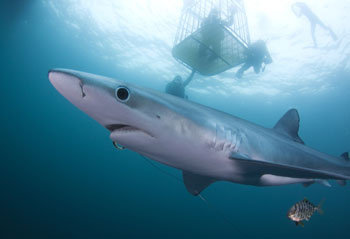Fishinar Series on pelagic fishing
There is still time to register for the free Ørsted Fishinar Series on pelagic fish being held Wednesday, December 9, 7 p.m. via Zoom. Learn to target tuna, mahi, sharks and other pelagic fish in the near offshore with Capt. John McMurray, One More Cast Charters; Capt. Charlie Donilon, Snappa Fishing & Diving Charters; and Dick Pastore, expert pelagic fish angler/RISAA member. Supply Ørsted, wind farm developer, with valuable input, learn about the reef effect at the Block Island Wind Farm, and fish abundance in European wind farms. Free tickets at https://districthallprovidence.org/calendar/ through the event listing and/or visit the Eventbrite registration page.
Climate change impacts are shifting locations of fish stocks
Climate change impacts are having serious effects on fish stocks on both our coasts, including stocks that are rebuilding. It’s going to take more to achieve sustainable management as ocean ecosystems continue to change.
Last month the National Oceanic & Atmospheric Administration (NOAA) in conjunction with Russian scientists released a study that linked warming Arctic temperatures, changing wind patterns and shifting currents brought on by climate change to movement of commercial valuable Alaskan pollock in the Bering Sea.
Robert Foy, NOAA’s Alaska Fisheries Science Center director said. “To get an accurate assessment of pollock abundance so that resource managers can set sustainable catch limits, we have to be able to understand pollock distribution, which certainly looks different under a warm water regime.”
Pollack in the Bering Sea is a good example of shifting stocks on the west coast and points to the need for international cooperation to prepare for climate change impacts on fisheries. Here in Rhode Island the fish and abundance of fish I catch today are different than the fish I caught ten years ago due to climate change impacts.
Warmer water fish such as black sea bass, summer flounder and scup are here today in abundance. They are now an integral part of my charter business.
Fish like summer flounder moving north has created havoc with allocation issues particularly in our commercial fishery. Mid Atlantic boats that have the quota but no fish in their waters, so they have moved up the coast to fish. And New England boats have the fish but little allocation. And, the sad news is that cold water fish such as winter flounder, American lobster and cod have gone to cooler/deeper water north and offshore.
Equitable solutions need to be worked out, we need a plan and to put tools in place so shifting stock issues due to climate change impacts can be addressed. We need to address this issue of shifting stocks so the fisheries in our region have a future.
Last month I had the honor to participating in an Environmental Defense Fund (EDF) sponsored roundtable discussion on ‘Adjusting fishery management as stocks shift’. The roundtable discussion had broad participation for recreational and commercial fishing, the science community, NOAA and members of east coast fisheries councils as well as the Atlantic States Marine Fisheries Commission.
The workshop discussed the thorny issue of identifying shifting stock allocation solutions optional for both fish stocks and fishermen. The aim of the workshop was be to build a consensus of solution directions that can be sent to fisheries decision-makers to inform their efforts as they address spatial shifts in fisheries stock changes in quota allocations that reflect both geographical shifts as well as historical catch. Output from the workshop has not been released yet.
Fish managers still have the responsibility to maintain sustainable fishing levels even with shifting stocks. We have no choice but to find ways to adapt. We have to create a management system that better accounts for climate change and is better equipped to deal with uncertainty.
When it comes to climate and fisheries, we need to continue doing the management practices we know are key parts of sustainability, like keeping fishing within Allocable Catch Limits (ACLs) and rebuilding overfished stocks. And, we need to make serious progress making our fisheries climate ready with new tools and approaches that are fair and take into consideration both historical catch as well as stock shifts.
In addition to dealing with the impacts on fisheries, we also need to address the root cause of climate change. Renewable energy sources, such as offshore wind farms, will help us fight climate change. I believe fisheries and responsible offshore wind development can coexist.
The Block Island Wind Farm is living proof. There, commercial gill nets are set up in the wind farm area, commercial boats trawl parallel to the wind farm and rod & reel commercial and recreational anglers are able to fish right up to the turbine pylons. At the Block Island Wind Farm fishing and offshore wind are working together, just as they should for the benefit of all the people of the United States of America.
Recreational and commercial fishers need to engage in climate change impacts dialogue by participating in allocation discussion at the state, regional and national level and advocate for funding of NOAA and Council initiatives to study climate impacts and possible allocation solutions. Additionally, anglers need to consider addressing and supporting solutions to the root cause of climate change impacts and the use of renewable energy like offshore wind farm and solar energy generation.
Where’s the bite?
Tautog, cod and black sea bass. Capt. Frank Blount of the Frances Fleet said, “The water has been on the dirty side due to high winds and seas. We were still able to put decent tautog catches together when able to get out this week. High hooks left with limit catches. Pool fish have been between 8-10 pounds. The water are still on the warmer side and the bite should continue to be for weeks to come. Cod fishing was also effected by the ground swell. The scup and sea bass did not care but the cod were keeping a low profile this week.”
Striped bass fishing in salt ponds has been good. Todd Corayer expert light tackle/fly fishing angler and author reports catching multiple striped bass in the slot range of 28” to less than 35” from his kayak. The bite along the southern coastal beaches has been good too when seas have been reasonable. Surf angling expert Gil Bell reports a good striped bass bite “Sunday morning was going to be my last outing but I caught and released a nice FAT slot striped bass so guess I’ll continue into December. I try to fish the pre-dawn hours that coincide with incoming or high tide. Big striped bass enter shallow water under cover of darkness and retreat to deeper water once the glow of sunrise appears.”
Dave Monti holds a captain’s master license and a charter fishing license. He is a RISAA board member, a member of the RI Party & Charter Boat Association, the American Saltwater Guides Association and the RI Marine Fisheries Council. Forward fishing news and photos to Capt. Dave at dmontifish@verizon.net or visit www.noflukefishing.com and his blog at www.noflukefishing.blogspot.com.









